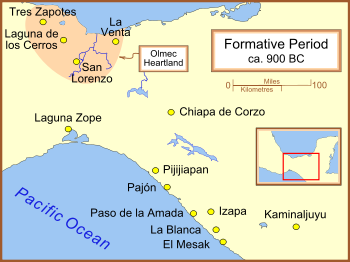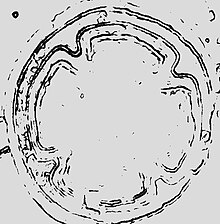
La Blanca is a pre-Columbian Mesoamerican archaeological site in present-day La Blanca, San Marcos Department, western Guatemala. It has an occupation dating predominantly from the Middle Preclassic (900–600 BC) period of Mesoamerican chronology. This site belongs to the later period of the Mokaya culture.
A minor archeological site nearby is Salinas La Blanca at the mouth of the Río Naranjo.
The site
At its peak, this was one of the largest known Mesoamerican sites of that era. It is located on the western Pacific coast, where it rose to become the major regional center following the decline of an earlier polity at Ojo de Agua, Chiapas.
La Blanca's regional dominance appears to have lasted approximately three centuries, until it was eclipsed by Ujuxte, 13 km east. This 300-year period is defined as belonging to the Conchas phase. The site covered over 200ha at its peak and boasted some of the earliest monumental architecture in Mesoamerica.
Mound 1
The site had the highest pyramid in the Pacific Lowlands at 25 meters high (Mound 1). It was built c. 900 BC, and was one of the first pyramidal temples in Mesoamerica, measuring 150 x 90m at its base.
Monument 3

Monument 3 was discovered in La Blanca Mound 9, in a residential zone thought to be largely or completely elite. Excavations of the mound initially revealed domestic features such as floors, burials.
Monument 3 is unique in Mesoamerican archaeology. Found on the western slope of the mound, it consists of a sculpture in the shape of a quatrefoil. It was formed of rammed earth, or sandy loam. The rammed earth was then coated with dark brown (nearly black) clay. The inner rim of the sculpture was painted with hematite red. The monument is 2.1 m in diameter
The La Blanca quatrefoil has a channel within the rim that probably carried water to the interior basin. The initial hypothesis is that the sculpture functioned as a locus of ritual in which water, or notions of fertility, were invoked. Such an idea is consistent with the quatrefoil shape, which in the Classic period iconography symbolizes a watery portal to the supernatural realm. Dating to approximately 850 B.C., the La Blanca sculpture appears to be the earliest example of a quatrefoil known in Mesoamerica.
The inclination of the external rings, the presence of the channel, as well as the concavity of the basin all suggest that Monument 3 was meant to contain liquid. Fluid would flow into the centre of the basin.
The use of water-filled basins in Preclassic-period Oaxaca provides a useful parallel, because such rituals were employed in rites of divination.
La Blanca figurines
Abundance of hand-modeled ceramic figurines have been found at La Blanca.
A series of figurines from La Blanca bear the puffy facial features associated with the Potbelly sculpture tradition, as well as with the massive heads of the Monte Alto culture.
Some of the figurines have facial features that anticipate those of the Monte Alto heads and potbellies, including the closed eyes with puffy lids and swollen cheeks.
Notes
- Love et al. 2005
- Love, M.; Guernsey, J. (2007). "Monument 3 from La Blanca, Guatemala: A Middle Preclassic earthen sculpture and its ritual associations". Antiquity. 81 (314): 920–932. doi:10.1017/S0003598X00096009.
- MARCUS, J. 1999. Men's and women's ritual in Formative Oaxaca, in D.C. Grove & R.A. Joyce (ed.) Social Patterns in Pre-Classic Mesoamerica: 67-96. Washington (D.C.): Dumbarton Oaks.
- Julia Guernsey, Rulers, Gods, and Potbellies: A Consideration of Sculptural Forms and themes from the Preclassic Pacific Coast and Piedmont of Mesoamerica. in: The Place of Stone Monuments: Context, Use, and Meaning in Mesoamerica's Preclassic Transition, eds. Julia Guernsey, John E. Clark, and Barbara Arroyo. Dumbarton Oaks. 2010.
References
- Coe, Michael D. (1961). La Victoria: An Early Formative site on the Pacific Coast of Guatemala. Papers of the Peabody Museum of Archaeology and Ethnology, Vol. 53. Cambridge MA: Peabody Museum of Archaeology and Ethnology, Harvard University. OCLC 3020676.
- Love, Michael; Julia Guernsey (2005). "The Context and Associations of Monument 3 from La Blanca, Guatemala". The Foundation Granting Department: Reports Submitted to FAMSI. Foundation for the Advancement of Mesoamerican Studies, Inc. (FAMSI). Retrieved 2007-02-12.
- Neff, Hector (2005). "Buscando las fábricas del Plomizo: Exploraciones geofísicas en el área de La Blanca, Costa Sur de Guatemala" (PDF). In Juan Pedro Laporte; Bárbara Arroyo; Héctor E. Mejía (eds.). XVIII Simposio de Investigaciones Arqueológicas en Guatemala, 2004: Museo Nacional de Arqueología y Etnología (2 vols.) (in Spanish). Guatemala City: Ministerio de Cultura y Deportes, Museo Nacional de Arqueología y Etnología; Asociación Tikal; and the Foundation for the Advancement of Mesoamerican Studies Inc. (FAMSI). pp. Report 100. OCLC 66464884. Retrieved 2008-01-15.
External links
- La Blanca - Description and Photos Archived 2007-12-14 at the Wayback Machine
14°35′43″N 92°08′19″W / 14.5951524°N 92.1386684°W / 14.5951524; -92.1386684
Categories: